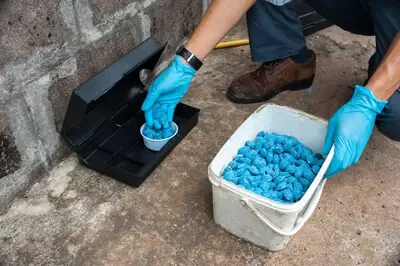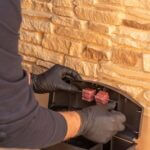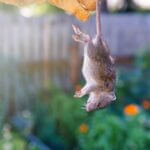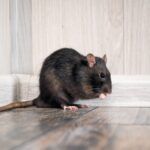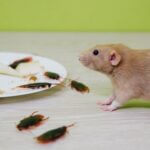Poison is a favored way to deal with a rat problem. However, once the rat has perished, you can’t leave a poisoned rat’s corpse to decompose because your house will smell.
You need to find the dead rat and throw it out, but this requires knowing the best places to look.
If the rat knows it’s sick or dying after eating rat poison, it’ll rest in a dark, quiet place. If the rat hasn’t experienced the poison’s effects yet, it may continue with its routine and die in a random location.
If the rat has kidney failure, it may come out in the open to find a water source before dying.
To locate a poisoned rat, you need to find its preferred nesting place. Look for poisoned rats in dark and secluded areas, such as inside walls, lofts, attics, basements, garages, and sheds.
Do Rats Take Poison Back to Nests?
Second-generation rat poisons work for 2-3 days. Most rats return to their nests after being poisoned, but it’s usually because they feel weak and disoriented, not because they realize they’re about to die.
During this time, a rat will make several trips. If the rat dies in its nest, other rats may also die from secondary poisoning if they eat the dead rat. However, poisoning a single rat will not kill all rats.
There’s a high chance that the other rats will ignore their dead companion if they’re already eating well. Most rats will need to be approaching starvation to engage in cannibalism.
Once a rat dies in its nest from poisoning, you can’t leave the dead body as it’ll start decomposing and emit a foul stench in your home. Large rats can take 3-4 months to decompose fully.
The decomposing carcass will invite more pests, such as flies, maggots, and cockroaches.
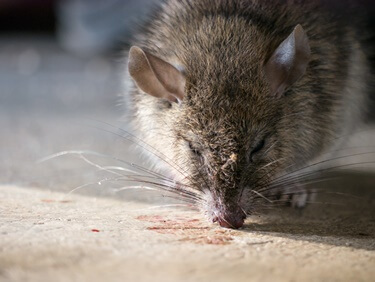
Where Will A Rat Die After Eating Poison?
Unfortunately, there’s no guaranteed way to know where a rat will die after consuming poisoned bate.
Once ingested, rat poison takes effect over several days. During this period, the rat may adhere to its normal routine and die somewhere on its usual foraging path.
Sometimes, the rat may die in its nest if the poison makes it too weak to move and forage for food. Sometimes, rats may retreat to their nests to rest (and die) after being poisoned.
Some poisons target the kidneys and work by dehydrating the rat. The rat eventually perishes from organ failure or a lack of water, whichever comes first. So, a poisoned rat desperately seeks out water.
It’ll be so desperate that it’s likely to come out in the open to find a water source. When it does, it’ll be exposed as the poison works, leaving it to die in plain sight.
Here are some of the favored resting places of poisoned rats:
- Behind large appliances, such as washers, dryers, ovens, and refrigerators.
- Under furniture, especially in areas of the home with limited footfall.
- In the garage, particularly around storage items and unused lawn equipment.
- Dark corners, such as in back rooms or neglected parts of guest rooms.
- Within the attic or basement space.
- Closets, especially in the back, in or around boxes, or underneath clothes.
- In the walls, especially if you’ve noticed signs of gnawing and rat holes.
How Does Rat Poison Work?
Several different rodenticides are available. Most work by baiting rats into eating them, causing the rodents to die slowly over the coming days.
Manufacturers craft palatable rodenticides since rats are ravenous eaters and can’t vomit unpalatable or toxic food. This fools rats into sampling new (poisoned) foods.
While these poisons have a high success rate for killing rats, some people view them as inhumane. They can also pose serious health hazards to humans, pets, and wildlife.
According to PLOS One’s study on rodenticide exposure and toxicosis in bald eagles, researchers found over 80% exposure rates from a sample size of 303 eagles.
The report also revealed that anticoagulant rodenticide toxicosis was the cause of death in 4% of the eagles examined. This shows just how dangerous these poisons are to non-rodents.
There are three main kinds of poisons, including the following:
Anticoagulants
Second-generation anticoagulants have a higher level of toxicity, requiring just one smaller dosage. They work by blocking rats’ vitamin K cycle so the body can’t clot blood (coagulate).
Anticoagulants damage the capillaries, resulting in internal bleeding. They kill rats due to anemia (lack of healthy red blood cells) or hemorrhagic shock (severe blood loss).
These drastically affect the delivery of oxygenated blood to the body’s cells and tissues.
Anticoagulants are a popular rodenticide because they delay the rodent’s death, meaning that rats are less likely to associate consumption with the cause of death.
Hypercalcemia
Hypercalcemia-based rodenticides require a single dose, utilizing Vitamin D2, Vitamin D3, and ergocalciferol or cholecalciferol to poison rats.
It’s toxic to rodents because they’re given an excess of phosphates and calcium.
While rodents need these nutrients to thrive, excess phosphates and calcium cause their bodies to malfunction. This harms various organs, leading to calcification, heart problems, and kidney failure.
The synergistic relationship between hypercalcemia and anticoagulant-based rodenticides means they’re often combined due to their higher level of efficacy.
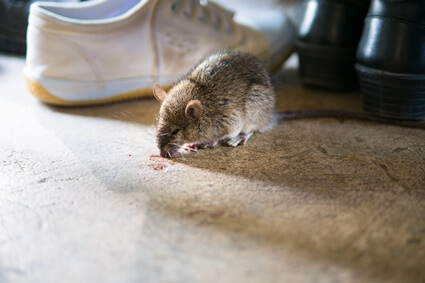
Metal Phosphides
We often turn to metal phosphides when rats have grown resistant to anticoagulants. There are various versions of metal phosphides, but Zinc phosphide is among the most common choices.
Metal phosphide interacts with rats’ digestive acids to create phosphine gas, which is a toxic substance. Rats will perish 1-3 days after consuming one dosage of metal phosphides (combined with bait).
How Long Does It Take For a Rat to Die After Eating Poison?
First-generation anticoagulants, such as warfarin and diphacinone, are slower-acting. Rats that consume a lethal dosage in a single feed will usually die within 4-6 days.
However, second-generation poisons such as bromethalin and brodifacoum work much faster, killing a rat from internal bleeding and low blood oxygenation within 2-3 days.
A median lethal dose for brodifacoum is 0.12 -0.172 milligrams per kilogram of body weight. The Indian Journal Of Critical Care Medicine notes that brodifacoum is 100% more potent than warfarin. Specifically, this is regarding its anticoagulant effects.
Some first-generation rat poisons, such as warfarin, have been used for decades. Over time, some rats have become resistant, rendering them less effective than new-generation poisons.
It’s impossible to precisely determine where rats will hunker down after ingesting rat poison. Look for quiet and secluded places where rats may rest or hide when feeling unwell.
If you have more than one rat, you’ll be able to take action to locate the others.

